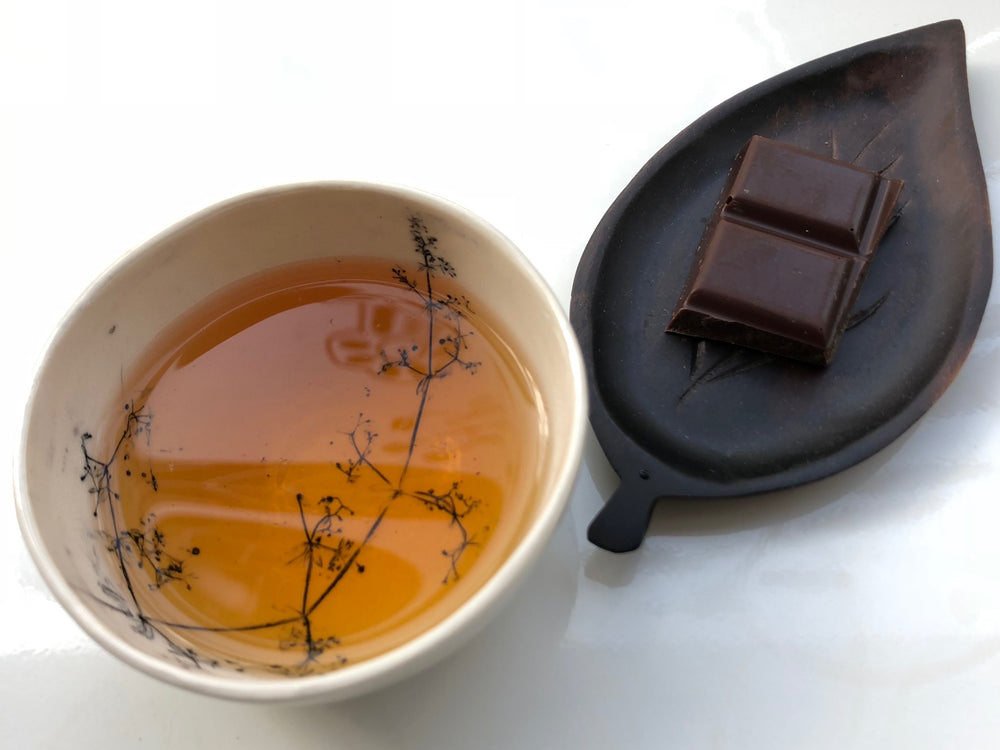Pu er is the best-known of the dark teas, known in China as black tea or hei cha. It can improve and mature over time. Depending on whether it is stored dry or wet, it will evolve differently.
The appellation pu er (or pu'er or pu erh, depending on the translation) is a Yunnan certification that protects the terroirs and processing of these teas. Other Chinese provinces, such as Guangxi and Guangdong, and countries such as Thailand, Vietnam, Burma and Laos also produce dark teas.
The transformation of dark tea is based on 2 processes: enzymatic oxidation of varying degrees of intensity, combined with microbial fermentation of varying degrees of intensity, which evolve over the course of the maturing process.
The first stage, just after harvesting, involves wilting for a few hours so that the leaves begin to dehydrate and soften. The second stage is, as with green tea, fixing with gentle dry heat to "kill the green" (sha qing), i.e. to kill enzymatic oxidation. Unlike green tea, however, the much gentler fixation process leaves some of the oxidase active. Tea makers can thus play on this residual enzymatic oxidation activity, which will contribute to a maturation style over the years. The current trend is for green pu ers, i.e. where very little enzymatic activity remains. The leaves are then rolled (rou cha) to release the juice and ensure even ripening. They then take on their characteristic oblong, twisted shape. They are then stored in the sun, or in a veranda, for several hours to several days, where they are said to slow-cook, in fact continuing to dehydrate gradually. The result is a raw tea known as mao cha. It is then sorted, with all the yellow leaves removed, and can be stored in bulk, often in jars, or compressed. This is pu er sheng cha or raw pu er.
In the 1970s, the Chinese developed another technique: wo dui (literally wet heap). This was the birth of shu pu er or ripe pu er. The initial aim was to reproduce, in accelerated form, the characteristics of aged raw pu er, or sheng, matured in wet storage. Indeed, one of their major consumer markets was Hong Kong, which was accustomed to consuming old pu er sheng stored in wet storage in Hong Kong. They were used to consuming old pu er sheng stored in Hong Kong, which made them evolve in a totally different way to the dry storage you might get from producers in Yunnan, or collectors in Malaysia or Taiwan. As a result, another style of pu er was born, which appealed to the Hong Kong market, but which never produced an equivalent of the old pu er sheng in wet storage!
We always start with the same material, pu er sheng. In general, we use leaves of lesser quality, rarely from large trees or old cultivated or wild trees, but rather from terraced cultivation. Once the tea has dried, it is placed in stacks around 60 cm thick, moistened and stirred regularly to ensure even leaf mould, where bacteria and fungi act on the leaf's development. This stage lasts around forty days, known as wo dui. The leaves are then dried and left loose, or compressed. So there's an accelerated and amplified microbial fermentation that naturally occurs with pu er sheng cha, but in a much slower and more diffuse way, in addition to natural oxidation over the years. It's an art to manage this fermentation so that the right ferments develop and not the wrong ones, which would give the tea a musty taste.
Pu er can be compressed into various forms for maturing. Historically, this method of preservation was practical for transporting, as it was much less bulky than loose tea, but also for bartering: for several centuries, it was a veritable currency of exchange. Shapes and weights vary. Among the most common are the wafer, or chi tse beeng cha, which weighs around 300g, the bird's nest, or tuo cha, which weighs some 100g, the brick of varying size, as well as mushrooms, melons and so on.
Depending on whether it's cooked or raw, its aromatic notes are highly variable and highly distinctive, ranging from velvety undergrowth, humus or animal notes in the case of ripe pu err to oriental notes from the world of perfumes, such as patchouli, cedar or sandalwood, with a certain vivacity for a fine raw pu er.
If you'd like to delve deeper, I invite you to read the 10 pu er portraits presented in my book Portraits de Thés : Journey to 40 tea-producing countries, where I explain the specificities of terroirs, tea bushes, storage and more.
And discover our collection of pu er








